GU DEXIN: ICONOCLAST
| May 21, 2012 | Post In LEAP 14
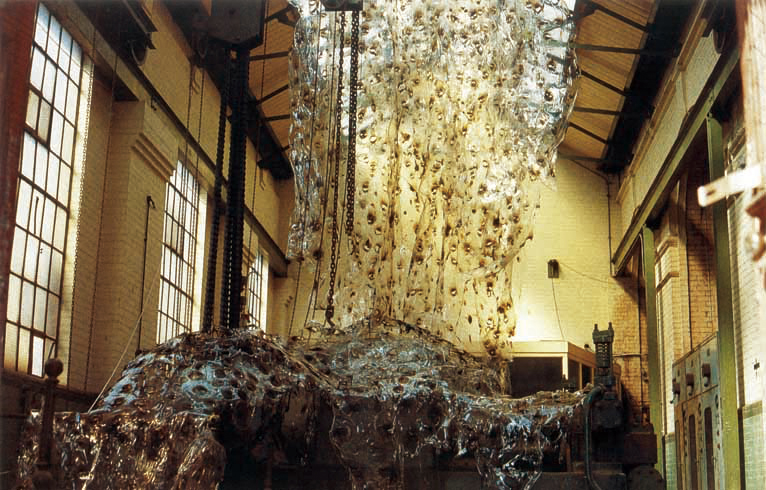
“2009-05-02” was the last series of work produced by Gu Dexin before he chose to retire from the art world completely. The title of the work came straight from the designated time frame for the exhibition at Galleria Continua Beijing— Gu frequently implements this policy, naming his works after simple external circumstances in order to defend against the accumulation of leading, intuitive interpretations. In this work, white-washed wooden panels on all four walls were covered with line after line of horrifying sentences in striking red paint: “We have killed people we have killed men we have killed women we have killed old people we have killed children we have eaten people we have eaten hearts we have eaten brains we have hit people we have punched their eyes out we have smashed in their faces…” With no punctuation and nothing to separate one utterance from the next, they repeat cyclically, summoning a wellspring of terror. Although the visual element here is entirely without accompanying imagery, vivid scenes of brutality nonetheless flash through our minds: social injustices, criminal offenses, blood-drenched, murderous warfare and terrorism, and so on. One thing worth noting is that the events that so often generate fear within us are not the concrete, actual events themselves or any moral responses they might provoke, but rather their very images as they flicker across the ocular surface, like so many film slides out of a phantom projector.¹ In “2009-05-02,” the connection in our consciousness between the words we see and the images we experience as a result not only embodies the intimate connection between text and image— between referentiality and visibility— but even more so points to the very sensory obstacle that the era in which we live has manufactured for us: image anxiety disorder. In this age, images are transmitted at an unprecedented rate; the traumatic spectacle is an invasive background to everyday life. The images we are inundated with are not objective records of true occurrences, nor are they mere reproductions of objects or their simulacra; rather, they take on a life of their own, actively inserting themselves into our very modes of behavior. Thus, an interpretation of “2009-05-02” must move beyond its textual expression and even beyond its mechanism as a dark social critique of violence and brutality as mapped by a more straightforward narrative. It may be that what “2009-05-02” aims to test, in fact, is the intricate and contradictory relationship between images produced out of acts of art and images produced out of acts of terrorism.
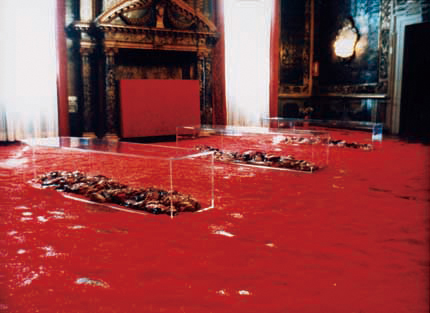
Of course, “fear” and “terror” together have always been one of art’s eternal themes. The evolution of representations of war is one long thread in the evolution of art history at large. In an essay titled “Art at War” in his 1998 book Art Power, Boris Groys points to the complementary relationship between art and war, and the violent tendencies unique to each. Classic pre-modernist artwork commonly depicts and narrates incidents of terrorism, with painted images meant to convey information about these events directly to the senses of the viewer. After the spread of photography and other imaging technologies, a means of recording events in real time had been realized, thereby eliminating the gap between reality and art’s function as a representational medium, along with the artist’s role as a coordinator between the two. Groys goes on to engage in a meaningful comparison between artistic creation and the terrorist act with regard to the way in which both produce images. He holds that since the start of the modernist era, avant-garde art has taken the toppling of traditions, the breaking of taboos, the destruction of routine, and the attack on existing forms as its strategy, fighting to conquer all manner of visual symbolism at any cost in the struggle for legitimacy, visibility, and identity in art. In striving for “visibility” and “identity,” art and politics are no different from one another, in principle. André Breton, in his renowned Surrealist Manifesto, asserted that the terrorist act of firing gunshots into an unassuming, innocent crowd was the truly surrealistic, artistic act. In Groys’ opinion, this can be seen as the most classic example of a quintessential overlap between the exaggeration of art and the exaggeration of violence.²
In Gu Dexin’s works, blood-ridden scenes of terror play the leading role, starting with his use of raw meat and animal innards. In 1995, Gu participated in the Fei Dawei-curated “Asiana,” a satellite show of the 46th Venice Biennale. The show used a magnificent Venice casino as its gallery.³ This was Gu’s first time using meat as his material; he filled three custom-made plexiglass coffins with 100 kilograms of bloody raw beef. The Venice exhibition took place at the height of summer, and the slabs of meat quickly rotted in the heat, emitting a sickly layer of fog that lined the inside of the plexiglass, at times revealing and at times obscuring the transformation of the meat in its chamber— thus further bewildering and arousing the audience’s urge to discern what was happening. Though these coffins were designed on the premise that they would be completely and securely sealed, a mere three days later the rancid odor of the rotting meat had intensified to an intolerable degree and the vapors were becoming gradually more toxic. The exhibition organizers were forced to remove all of the decaying meat, leaving the empty coffins stained with trails of blood and other viscous residue. For another piece in 1998, Gu chose yet another, even more grotesque organic material: raw pig brains. This time, he tiled a red tablecloth with 100 kilograms of pig brains and suspended a second, pig-brain-free red cloth at the table’s front. The work was shown in “Trace of Existence: A Private Showing of China Contemporary Art ’98,” curated by Feng Boyi at Now Studio in Beijing. One possible analysis of the work, from the perspective of its symbolism, would view the red cloth as a political metaphor, and the big brains as an insinuation of the “heads” of state behind the great mechanism that is politicized society,⁴ but this sort of interpretation inevitably tends towards an overemphasis on representation. In one interview, when asked why he chose pig brains as material, Gu succinctly replied: “The physical nature of the pig’s brain most closely resembles that of the human brain.”⁵
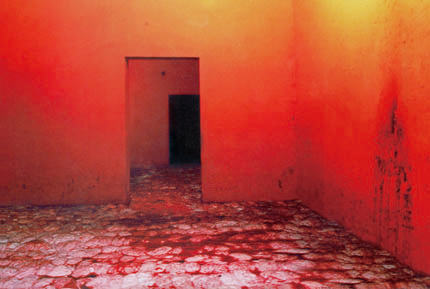
Japanese simulation robotics scientist Masahiro Mori used his research to posit a theory based on Freud’s “The Uncanny”; he called it “The Uncanny Valley.” Mori’s theory holds that when a robot shares certain similarities to human kind, but not too many similarities, it will make people feel a pleasurable sense of affinity. However, at the point where similarity— without arriving at exact likeness— reaches an extreme degree, it will produce in people a sensation of utter terror and revulsion.⁶
Gu Dexin uses the pig brain, that much more “physically similar to the human brain” to maximize the force of this psychological test. His attempt to recreate “The Uncanny Valley” appears once again in a series of works from 1999. Gu took an array of realistic sex toys and inserted them into or interspersed them among the sinews, blood, fat, and muscle of slabs of skinned poultry and raw meat; turned on, the toys vibrated unceasingly into the meat, creating a scene that came so close to reality and yet simultaneously so far from it sent a visceral shudder through the body. Gu Dexin’s proclivity for red further inflames the experience of this kind of psychological convulsion; entering into his bloody spaces, one cannot help but think of the classic scene in David Lynch’s suspenseful serial drama Twin Peaks when, in the protagonist’s recurring dream, a dwarf dressed in a red suit predicts the future in a slow drawl from within an unnamed, mysterious space draped with deep red curtains. The true meaning of Gu’s works lies not in the freedom with which we can entreat to interpret their symbolism. Rather, it lies in the actual, lived experience of much deeper human psychological and physical pressures: the twisted, the absurd, the craved; voyeurism, violence, ritual sacrifice— anything and everything that probes, pushes, and destabilizes.
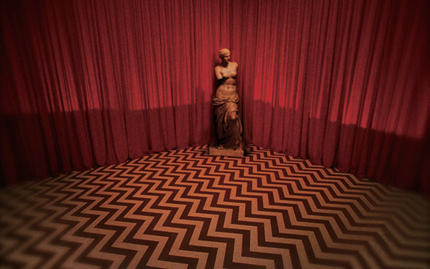
No one can deny that Gu Dexin is a master of large-scale spectacle. Most of his works are based upon the architecting of environmental installations of giant proportions requiring materials that often must be measured by the kilogram. But are his works satisfied to stop at that— at the production of a landscape and its resounding shock? It is obvious that Gu’s intention is to build an installation, not to erect an immortalizing monument, and his materials of choice make this point quite clear. Everyday objects that easily could have been handpicked at random are actually the result of careful consideration. From the early plastics and later to raw meat, apples, bananas, strawberries, and so on, Gu has a consistently firm grasp on the relationship between the impermanence so central to these objects and the natural process of their transformations. These are objects that gradually decay and transform with the passage of time into unintelligible, unrecognizable, indefinable substances. And so a scene that at first possesses the features of a monument, then moves with time, and sheds the absolutist allure of eternal existence. In Gu’s mind, the rotting process is not a dichotomous transformation from “good” to “bad,” because the existence of such a dualism is already marked by blatant absurdity.
In his early works, Gu Dexin used an abundance of plastic: for 1989’s “Magiciens de la Terre” he heated and deformed a Chanel perfume bottle before hanging it across strips of warped, molten plastic; in 1990 he melted and scorched an enormous sheet of plastic and hung it up in an electric power station in London; in 2002 at the first Guangzhou Triennial, Gu filled a giant metal frame with feverishly distorted plastics. Through their forms and the materials that constituted them, these works beckon associations with the conceptual artists of 1960s America, represented by Robert Smithson, Donald Judd, and Sol LeWitt. In an essay titled “Entropy and The New Monuments,” Smithson analyzes the way in which his generation of artists understood and applied the concept of “entropy” in their creative work. “Entropy” or “energy loss” was a concept at first exclusive to physics: according to the second law of thermodynamics, the amount of energy lost is always greater than the amount of energy available at any given time, and as such, everything in the universe tends toward entropy. To the artists of that generation it was clear that as human society evolved and energy was continually lost, the flame of the universe would one day burn out. Post-war America was the pinnacle of urban development; innumerable real estate development projects sprung up like ravenous plant-life after an oppressive rain, frenzied large-scale production inspired wanton consumption. It was a sight that, upon first glance, might have been a picture of prosperity. On the contrary, it left many artists feeling gravely perplexed. Judd once remarked, “All of these visible things are actually bland and empty.”⁷ In response, they used synthetic materials such as plastic and steel to create formally minimalist installation pieces that could reflect this experience of “nothingness” among so many “somethings.”⁸ In the early 1990s, Gu’s sensitivity towards plastics and industrial waste was similarly inextricable from the budding economic development that marked its context. Although the forms he used and the materials that constituted them would gradually evolve, the notion of “entropy” continued to be interspersed throughout Gu’s work; a luscious “carpet” of plentiful fruit was doomed to an irreversible fate of rot, deterioration, and total deconstruction.
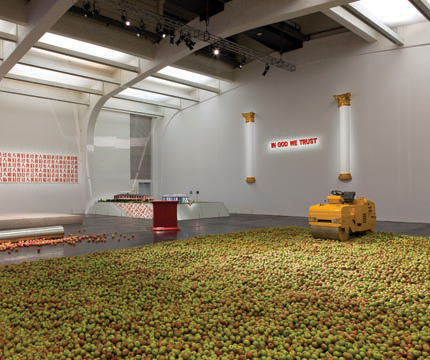
Gu Dexin’s investigation of time is crucial to understanding the anti-memorial nature of his works. His exhibition “2007-1-13” turned Galleria Continua’s space in San Gimignano, Italy into an abandoned movie theater. Gu covered the theater floor in fresh bananas, and dragged in ten austere marble columns topped with ornate Roman vases to be stationed on either side of the banana carpet. The red curtains in front of the movie screen, closed shut, emanated intense ritualism. It was as if time had coagulated there, its march forward slowly coming to a halt as it found itself caught in a sort of complementary orbit with the space of the theater itself. The experience of watching a film in a theater is the experience of a time warp; time in limited space undergoes unlimited compression. Through photographic records, the past and the present in “2007-1-12” are able to be lodged tightly into one moment; only on the physical surface of photo print paper can the contrast between the bananas of once-golden freshness and the bananas of brownish yellow rot be rendered together in the now. This kind of temporal experience is devoid of any spatial component; it does not move forward or backward, it does not move at all. As Smithson poses: “If time is a place, then innumerable places are possible. Rather than saying, ‘What time is it?’ we should say, ‘Where is the time?’”⁹
But let us return at last to the original question, of the contradictory relationship between images of art and images of terror. In his essay, Groys boldly positions art and violence on the same plane for comparison, but he ultimately still defends the position that sees art as an essentially constructive act, not a destructive one. He feels that images produced in the name of terror are born out of conspiring plots that seek to raise these images onto a pedestal of collective memory, endowing them with features of the “sublime” in order to fabricate a memorialized idolatry that will mesmerize audiences into believing in a kind of absolute truth. Whereas art images are meant to pass judgment upon those sights designed to bewitch our eyes and ears, they are here to smash idols and put a stop to idol-worship. The ultimate responsibility of art images lies in their unremitting confrontation with paradox as they contemplate and wrestle with the nature of existence. Gu Dexin’s often absurd and contradictory visual language reached its extreme in “2007-4-14,” where maggots hidden beneath drain covers and flies floating atop blue ponds free themselves from day-to-day reality and release into the space of the imagination, forcing us to rethink all that may have once been known as ugly, beautiful, moral, shameful, majestic, tiny, dirty, or pure.
Gu Dexin is a true iconoclast, to the extent that he has chosen to no longer create the art image itself.
1 Ed. note: The concept of the “image” here is treated as distinct from the concept of the “picture,” as it transcends the notion of physical media like painting, photography, digital photography, film, and so on.
2 Boris Groys, “Art at War,” Art Power, Cambridge: MIT Press, 2008, 121-129.
3 Karen Smith, “Gu Dexin,” Nine Lives: The Birth of Avant-Garde Art in New China, Scalo, New York, 2005, 205.
4 Ibid, 209.
5 Gu Dexin, interview, Shanghai Gallery of Art: http://www.shanghaigalleryofart.com/cn/artists_reviewPop.asp?id=12
6 Masahiro Mori, “The Uncanny Valley,” Energy vol. 7 no. 4, 1970, 10,000 Lives: Gwangju Biennale
2010, Gwangju Biennale Foundation, 317-318.
7 Robert Smithson, “Entropy and the New Monuments,” Robert Smithson: The Collected Writings, University of California Press, 11, 13.
8 “… one perceives the ‘facts’ of the outer edge, the flat surface, the banal, the empty, the cool, blank after blank; in other words, that infinitesimal condition know as entropy.” Ibid, 13.
9 Ibid, 11.

